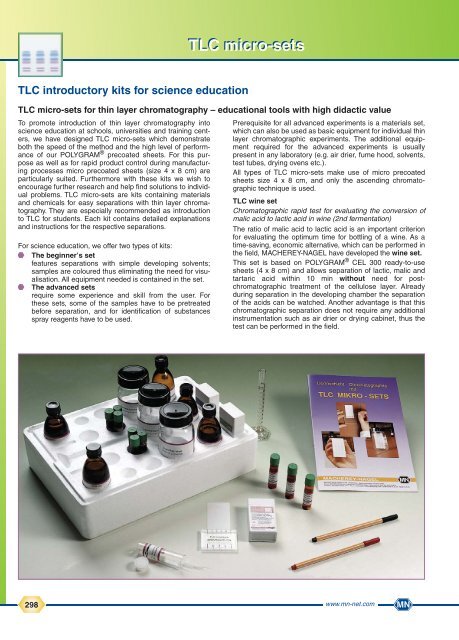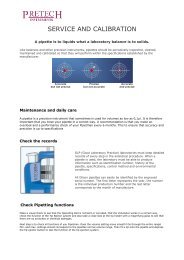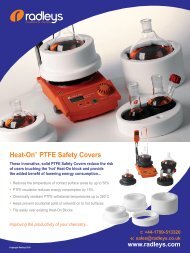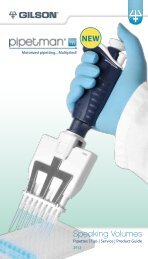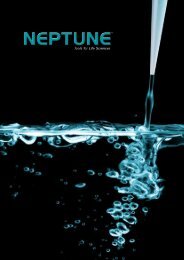TLC Micro-Sets e.fm - Pretech Instruments
TLC Micro-Sets e.fm - Pretech Instruments
TLC Micro-Sets e.fm - Pretech Instruments
You also want an ePaper? Increase the reach of your titles
YUMPU automatically turns print PDFs into web optimized ePapers that Google loves.
<strong>TLC</strong> micro-sets<br />
<strong>TLC</strong> micro-sets<br />
<strong>TLC</strong> introductory kits for science education<br />
<strong>TLC</strong> micro-sets for thin layer chromatography – educational tools with high didactic value<br />
To promote introduction of thin layer chromatography into<br />
science education at schools, universities and training centers,<br />
we have designed <strong>TLC</strong> micro-sets which demonstrate<br />
both the speed of the method and the high level of performance<br />
of our POLYGRAM ® precoated sheets. For this purpose<br />
as well as for rapid product control during manufacturing<br />
processes micro precoated sheets (size 4 x 8 cm) are<br />
particularly suited. Furthermore with these kits we wish to<br />
encourage further research and help find solutions to individual<br />
problems. <strong>TLC</strong> micro-sets are kits containing materials<br />
and chemicals for easy separations with thin layer chromatography.<br />
They are especially recommended as introduction<br />
to <strong>TLC</strong> for students. Each kit contains detailed explanations<br />
and instructions for the respective separations.<br />
For science education, we offer two types of kits:<br />
The beginner’s set<br />
features separations with simple developing solvents;<br />
samples are coloured thus eliminating the need for visualisation.<br />
All equipment needed is contained in the set.<br />
The advanced sets<br />
require some experience and skill from the user. For<br />
these sets, some of the samples have to be pretreated<br />
before separation, and for identification of substances<br />
spray reagents have to be used.<br />
Prerequisite for all advanced experiments is a materials set,<br />
which can also be used as basic equipment for individual thin<br />
layer chromatographic experiments. The additional equipment<br />
required for the advanced experiments is usually<br />
present in any laboratory (e.g. air drier, fume hood, solvents,<br />
test tubes, drying ovens etc.).<br />
All types of <strong>TLC</strong> micro-sets make use of micro precoated<br />
sheets size 4 x 8 cm, and only the ascending chromatographic<br />
technique is used.<br />
<strong>TLC</strong> wine set<br />
Chromatographic rapid test for evaluating the conversion of<br />
malic acid to lactic acid in wine (2nd fermentation)<br />
The ratio of malic acid to lactic acid is an important criterion<br />
for evaluating the optimum time for bottling of a wine. As a<br />
time-saving, economic alternative, which can be performed in<br />
the field, MACHEREY-NAGEL have developed the wine set.<br />
This set is based on POLYGRAM ® CEL 300 ready-to-use<br />
sheets (4 x 8 cm) and allows separation of lactic, malic and<br />
tartaric acid within 10 min without need for postchromatographic<br />
treatment of the cellulose layer. Already<br />
during separation in the developing chamber the separation<br />
of the acids can be watched. Another advantage is that this<br />
chromatographic separation does not require any additional<br />
instrumentation such as air drier or drying cabinet, thus the<br />
test can be performed in the field.<br />
298<br />
www.mn-net.com<br />
MN
<strong>TLC</strong> micro-sets<br />
<strong>TLC</strong> micro-sets<br />
<strong>TLC</strong> introductory kits for science education<br />
Basically, for <strong>TLC</strong> micro-sets the same steps apply as described<br />
in the chapter "Principle steps of a thin layer chromatographic<br />
separation". After application of the sample with a<br />
glass capillary and evaporation of the solvent the micro precoated<br />
sheet is developed. <strong>TLC</strong> micro-sets use a simple<br />
glass bottle with screw cap as developing tank. Place the micro<br />
precoated sheet into the glass bottle, which is charged<br />
with about 10 ml of the developing solvent. Screw the cap on<br />
to the bottle while you hold the glass firmly on the table, so<br />
that the surface of the developing solvent is not disturbed.<br />
Please take care, that the solvent does not unevenly touch or<br />
splash over the applied spots. The solvent ascends through<br />
the layer by capillary action and causes the substances to be<br />
separated. When the solvent front has reached the desired<br />
height (about 6 to 7 cm) stop the separation by removing the<br />
sheet from the development tank. Immediately mark the solvent<br />
front with a soft lead pencil.<br />
After chromatographic separation all colourless substances<br />
have to be made visible. For our beginner's set we have chosen<br />
dyes, i.e. coloured substances, which can be recognised<br />
without further treatment. The substances separated with the<br />
advanced sets are colourless as is usually the case in practice.<br />
For visualisation you will use spray reagents as detailed<br />
in the instructions for the sets.<br />
<strong>TLC</strong> micro-set A for beginners<br />
This kit contains all chemicals and accessories for the following<br />
separations:<br />
➜ separation of the fat-soluble (lipophilic) dye mixture 1: butter<br />
yellow, indophenol, sudan blue II, sudan red G<br />
➜ separation of a mixture of anthraquinone dyes (test dye<br />
mixture 2): blue 1, blue 3, green, green blue, red, violet<br />
1, violet 3<br />
➜ separation of a mixture of food dyes (test dye mixture 3):<br />
brilliant black BN (E151), fast red E, erythrosine (E127),<br />
yellow orange S (sunset yellow CFC, E110), naphthol red<br />
S, ponceau 4 R (E124), tartrazine (E102)<br />
➜ separation of dyes from felt tip pens<br />
Contents of <strong>TLC</strong> micro-set A for beginners<br />
1 manual<br />
3 developing chambers<br />
50 glass capillaries 1 µl<br />
1 spotting guide<br />
1 measuring cylinder10 ml<br />
50 polyester sheets 4 x 8 cm each of POLYGRAM ®<br />
SIL G/UV 254 , ALOX N/UV 254 and CEL 300<br />
8 ml each of test dye mixture 1 (4 lipophilic dyes), test<br />
dyes sudan res G, and sudan blue II<br />
8 ml each of test dye mixture 2 (7 anthraquinone<br />
dyes), test dyes blue 1 and violet 2<br />
8 ml each of test dye mixture 3 (7 food dyes),<br />
test dyes yellow orange S, and brilliant black BN<br />
100 ml each of toluene, toluene/cyclohexane (2:1, v/v)<br />
chloroform/acetone (1:1, v/v)<br />
2.5% sodium citrate solution<br />
25% ammonia/2-propanol (5:3, v/v)<br />
2 felt tip pens<br />
<strong>TLC</strong> micro-set M<br />
This kit is prerequisite for the separations with kits F 1 to F 3.<br />
In addition, it serves as basic equipment for the individual<br />
study of further thin layer chromatographic experiments.<br />
Contents of <strong>TLC</strong> micro-set M (materials kit)<br />
2 x 50 glass capillaries 1 µl, 2 spotting guides<br />
1 rubber cap for capillaries, 1 measuring cylinder 10 ml,<br />
1 beaker 25 ml, 2 developing chambers<br />
1 glass laboratory sprayer with rubber bulb<br />
1 plastic syringe 1 ml<br />
20 sheets filter paper MN 713 (15 x 21 cm)<br />
50 polyester sheets 4 x 8 cm each of POLYGRAM ® SIL<br />
G/UV 254 , ALOX N/UV 254 and CEL 300<br />
Ordering information<br />
Designation Pack of Cat. No.<br />
<strong>TLC</strong> micro-set A for beginners 1 kit 814000<br />
Replacement parts for <strong>TLC</strong> micro-set A<br />
Test dye mixture 1, solution of 4 lipophilic dyes in toluene (components see above) 8 ml 814001<br />
Test dye mixture 2, solution of 7 anthraquinone dyes in chloroform (components see above) 8 ml 814002<br />
Test dye mixture 3, aqueous solution of 7 food dyes (components see above) 8 ml 814003<br />
Collection of 4 individual components of test dye mixture 1 4 x 8 ml 814011<br />
Collection of 7 individual components of test dye mixture 2 7 x 8 ml 814012<br />
Collection of 7 individual components of test dye mixture 3 7 x 8 ml 814013<br />
Sodium citrate, 2.5 g in 100 ml bottles to fill up with distilled water 2.5 g 814029<br />
<strong>TLC</strong> micro-set M (materials kit) 1 kit 814100<br />
For spray reagents see page 308.<br />
MN<br />
www.mn-net.com<br />
299
<strong>TLC</strong> micro-sets<br />
<strong>TLC</strong> micro-sets<br />
<strong>TLC</strong> introductory kits for science education<br />
<strong>TLC</strong> micro-set F 1<br />
This kit contains all chemicals required<br />
➜ for the separation of amino acids (test mixture, consisting<br />
of alanine, arginine, tryptophan and valine)<br />
➜ for the separation of amino acids in urine<br />
➜ for the separation of the heavy metal cations cobalt(II),<br />
copper(II), manganese(II), and nickel(II)<br />
Contents of <strong>TLC</strong> micro-set F1<br />
1 manual<br />
50 glass capillaries 1 µl<br />
50 polyester sheets 8 x 4 cm each of POLYGRAM ® SIL<br />
G/UV 254 and CEL 300<br />
100 ml each of n-butanol, ninhydrin spray reagent (0.2%<br />
in ethanol), acetone, 25% ammonia, rubeanic acid spray<br />
reagent<br />
50 ml each of 50% acetic acid, 18% hydrochloric acid<br />
8 ml each of the amino acid test mixture (see above),<br />
tryptophan and arginine reference solutions<br />
8 ml each of the heavy metal cation test mixture (see<br />
above), Co 2+ , Mn 2+ , and Ni 2+ reference solution<br />
<strong>TLC</strong> micro-set F 2<br />
This kit contains all chemicals required<br />
➜ for the analysis of edible fats<br />
➜ as well as for analysis of fats and cholesterol in blood<br />
Contents of <strong>TLC</strong> micro-set F2<br />
1 manual<br />
50 glass capillaries 1 µl<br />
50 polyester sheets 4 x 8 cm POLYGRAM ® SIL G/UV 254<br />
5 blood lancets, 5 disposable pipettes 25 µl,<br />
5 alcoholic pads,<br />
5 sample vials N 11-1 (2 ml) with PE caps and seals,<br />
3 sample vials 30 ml (for butter, margarine and edible oil)<br />
100 ml each of chloroform, methylene chloride, toluene<br />
and molybdatophosphoric acid spray reagent<br />
50 ml acetone with calibrated pipette<br />
8 ml cholesterol reference solution<br />
<strong>TLC</strong> micro-set F 3<br />
This kit contains all chemicals required<br />
➜ for the separation of analgetics (pain relievers)<br />
➜ and for drug analysis as shown for cinchona bark.<br />
Contents of <strong>TLC</strong> micro-set F3<br />
1 manual, 50 glass capillaries 1 µl<br />
50 polyester sheets 4 x 8 cm POLYGRAM ® SIL G/UV 254<br />
5 Aspirin ® tablets, 5 Thomapyrin ® tablets, 20 folded filters<br />
MN 615 1 / 4 , 11 cm diameter, 3 sample vials 8 ml (for<br />
Aspirin sample, Thomapyrin sample, cinchona bark extract),<br />
5 g cinchona bark, 100 ml each of chloroform,<br />
methanol, toluene/diethyl ether (55:35, v/v), spray reagent<br />
for caffeine and Dragendorff-Munier spray reagent, 50 ml<br />
each of iron(III) chloride solution and potassium hexacyanoferrate<br />
solution, 30 ml glacial acetic acid/ethyl acetate<br />
(6:2,5, v/v), 25 ml each of 12.5% ammonia and diethylamine,<br />
8 ml each of caffeine, paracetamol, quinine reference<br />
solutions<br />
<strong>TLC</strong> wine set<br />
Chromatographic rapid test for the determination of malic,<br />
lactic, and tartaric acid in wine (evaluation of the conversion<br />
of malic to lactic acid, 2nd fermentation)<br />
Contents of the <strong>TLC</strong> wine set<br />
The kit contains 50 polyester sheets POLYGRAM ® CEL<br />
300 (4 x 8 cm) as well as all substances (cation exchanger,<br />
eluent, reference substances) and required equipment<br />
(developing chamber, capillaries, spotting guide),<br />
and a detailed instruction leaflet.<br />
300<br />
www.mn-net.com<br />
MN
<strong>TLC</strong> micro-sets<br />
<strong>TLC</strong> micro-sets<br />
<strong>TLC</strong> introductory kits for science education<br />
Ordering information<br />
Designation Pack of Cat. No.<br />
<strong>TLC</strong> micro-set F1 1 kit 814200<br />
Replacement parts for <strong>TLC</strong> micro-set F1<br />
Amino acid test mixtures (for components see page 300) 8 ml 814201<br />
Collection of 4 individual components of the amino acid test mixture 4 x 8 ml 814202<br />
Cation test mixture (for components see page 300) 8 ml 814204<br />
Collection of 4 individual components of the cation test mixture 4 x 8 ml 814205<br />
<strong>TLC</strong> micro-set F2<br />
1 kit 814300<br />
Replacement parts for <strong>TLC</strong> micro-set F2<br />
Cholesterol reference solution 8 ml 814301<br />
<strong>TLC</strong> micro-set F3 1 kit 814400<br />
Replacement parts for <strong>TLC</strong> micro-set F3<br />
Quinine reference solution 8 ml 814405<br />
Paracetamol reference solution 8 ml 814406<br />
Caffeine reference solution 8 ml 814407<br />
<strong>TLC</strong> wine set<br />
1 kit 814500<br />
Replacement parts for all <strong>TLC</strong> micro-sets<br />
<strong>TLC</strong> polyester sheets POLYGRAM ® SIL G/UV 254 , 4 x 8 cm 4 x 50 814025<br />
<strong>TLC</strong> polyester sheets POLYGRAM ® ALOX N/UV 254 , 4 x 8 cm 4 x 50 814026<br />
<strong>TLC</strong> polyester sheets POLYGRAM ® CEL 300, 4 x 8 cm 4 x 50 814027<br />
<strong>TLC</strong> polyester sheets POLYGRAM ® 4 x 8 cm: 100 x SIL G/UV 254 ; 50 x ALOX N/UV 254 ; 50 x CEL 300 1 set 814028<br />
For spray reagents see page 308.<br />
<strong>TLC</strong> accessories<br />
Designation Pack of Cat. No.<br />
Simultaneous developing chamber 1 814019<br />
for <strong>TLC</strong>, 20 x 20 cm, for up to 5 plates<br />
Developing chambers for <strong>TLC</strong> micro-sets<br />
4 814021<br />
Glass laboratory sprayer with rubber<br />
1 814101<br />
bulb<br />
Glass capillaries 1 µl 3 x 50 814022<br />
Rubber caps for capillaries 2 814102<br />
Plastic syringe, 1 ml content with<br />
1 814104<br />
gradation<br />
Spotting guides 2 814023<br />
Measuring cylinders, glass, 10 ml<br />
2 814024<br />
content<br />
Filter paper MN 713, 15 x 21 cm 100 814103<br />
Folded filters MN 615 1/ 4 , 11 cm Ø 100 531011<br />
Chromatography paper MN 260,<br />
7.5 x 17 cm (for chamber saturation)<br />
100 814030<br />
<strong>TLC</strong> simultaneous<br />
developing<br />
chamber<br />
20 x 20 cm, for up to 5 plates<br />
MN<br />
www.mn-net.com<br />
301


